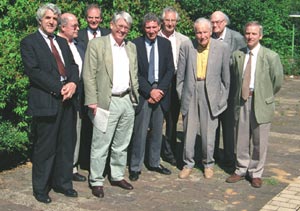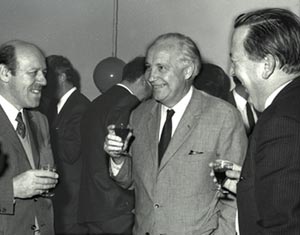Born in Vienna in 1911, Willibald Jentschke received his PhD in 1935 after studying nuclear physics under Georg Stetter. He then continued to work on nuclear physics at the University of Vienna. In 1939, he published a very important and topical paper with the title “Ueber die Uranbruchstuecke durch Bestrahlung von Uran mit Neutronen” (“On the fragments of uranium from irradiating uranium with neutrons”).

After the war he was invited to the US, where he became professor at the University of Illinois in Urbana and, in 1951, director of the Cyclotron Laboratory. After 1955, research in nuclear physics – which included high-energy physics – was again allowed in the Federal Republic of Germany. Accordingly, attempts were made to bring research on these subjects in Germany back up to international standards. In the search for personalities who could help to make a new start, Jentschke was an obvious choice, since he had already made a reputation for himself in Vienna and later in the US.
When the University of Hamburg offered him a chair of physics in 1955, he found a positive climate for supporting research in general, and a positive reception to his proposal to build a new institute of physics around a modern particle accelerator. However, the scope of his vision far exceeded what Hamburg officials were accustomed to. He demanded DM 7.5 million, a fantastic sum at that time, and quite outside the normal possibilities of the “Freie and Hansestadt Hamburg”. It is a great tribute to Jentschke’s scientific vision, his competence, his enthusiasm and his ability to communicate these qualities that he succeeded after long and patient negotiations in having this sum granted to him. It turned out to be the seminal funds for the construction of DESY, the German electron synchrotron.
A great help in deciding the all-important question of which accelerator to build was provided by an international accelerator conference at CERN in 1956. There, Jentschke met with German colleagues who were already active in accelerator building at CERN and at German universities. There was agreement that there should be a concentrated German effort at one site, resulting in a laboratory able to compete internationally, and which would be complementary to the programme at CERN. These requirements led to a plan to build a large electron accelerator, and Hamburg was an obvious choice for the site.
Such a machine could obviously not be built with the funds of the state of Hamburg alone. After long negotiations with the federal government and the German states (Länder), a financial agreement was finally reached and signed on 18 December 1959 – the date that DESY was officially founded. Jentschke became the first director of DESY, a position he held until he became director-general of CERN in 1971.

The role of Jentschke in these decisive years cannot be underestimated. His enthusiasm, his optimism, his tenacity in following his vision and his skill in negotiating with the authorities and in finding allies must have been very impressive. Even before the official founding date he started with the design of the laboratory, making it his own personal project, and working with a small group of devoted people. This early initiative was very important because, among other things, it gained time in building the laboratory.
Planning and policy
When the financial and administrative difficulties came close to a solution, Jentschke turned to the equally important questions of physics and research policy. Firstly, the decision was taken to build an electron synchrotron and not a linear accelerator. This allowed DESY to hold its own against the competition of the Stanford Linear Accelerator, which was built somewhat later and had a superior beam energy. Secondly, Jentschke supported with great determination a policy that opened DESY, with favourable conditions, to outside users from the German universities and from the Max Planck Society. The German universities were actually included in the process of long-range scientific planning. This policy, which emphasized the service function of DESY, proved to be a decisive advantage for the future because it attracted talent from all over Germany and, later on, internationally. In fact, long before international co-operation became a catchword, Jentschke supported the participation of scientists from outside Germany. This was the beginning of a gradual opening of DESY to international use – a feature that was to become so important for the laboratory’s future.
Building the 7.5 GeV electron synchrotron was a very difficult task because there was very little experience available in Germany. Jentschke succeeded in enlisting a team of young and enthusiastic physicists and engineers who took up the challenge. A key ingredient of their success was the spirit of teamwork that Jentschke created and the great human qualities he displayed in his leadership. Unselfish help was given by M Stanley Livingston, who at the same time was constructing the Cambridge Electron Accelerator at Harvard University in competition with DESY. Help also came from CERN, from where Hans Otto Wüster brought back advice on the optics of the machine. And so the DESY synchrotron delivered its first beam on 26 February 1964.
Establishing an experimental programme for the electron synchrotron was another critical task that rested on Jentschke’s shoulders. Again, this was a field in which very little experience existed in Germany at the time. Jentschke succeeded in recruiting a first-rate team of young experimental physicists from inside and outside Germany – his charm and enthusiasm went far in persuading people to come to the new laboratory, whose accelerator was still being built. He approached the German universities to send teams to Hamburg, and he encouraged international collaboration right from the beginning.
Under the leadership of Peter Stähelin and Martin Teucher, DESY’s experimental programme got off to a successful start. S C C Ting’s work on testing QED gave DESY early recognition. Naturally, electron-proton scattering was one of the key research activities. Teams led by Friedhelm Brasse, Herwig Schopper and Gustav Weber were soon presenting data that were second to none.

Photoproduction was the other large part of the programme. There, results achieved with a polarized photon beam from a diamond target won the prestigious Physikpreis of the German Physical Society for a team of young physicists in 1970. A hydrogen bubble chamber, built at Saclay, covered the subject of more complex photoproduction reactions. A comprehensive programme on photoproduction was carried out with this chamber. The collaboration also included a team from East Germany, not a trivial thing in those times.
Synchrotron success
In addition to high-energy physics, Willibald Jentschke recognized the potential of research with synchrotron radiation from the beginning and supported it strongly. This initiative was another of his visions, which was to become very important for the future. Stähelin, who as director of research was the driving force for establishing a successful research programme in synchrotron radiation, shared his vision. This early initiative led eventually to Hasylab, the large synchrotron radiation laboratory at the DORIS storage ring. The key people in this development played a role in the development of synchrotron radiation activities from the original “Hänselbunker” at the synchrotron to the big expansion coming with the DORIS storage ring. They brought in important outside users such as IBM, the Max Planck Society and the European Molecular Biology Laboratory, and finally led to the foundation of Hasylab.
Jentschke was well ahead of his time in many important respects. Decades before the word “outreach” was coined, he saw to it that the work of DESY was communicated to the public: there were open days at DESY for the laboratory’s neighbours, articles in popular magazines and the beginning of a public relations group. There were many beneficial effects from this; for example, the resulting good relations with the neighbours proved very important when DESY had to expand beyond its original site to build HERA.
A few years after the successful start of DESY the question of the next project posed itself. The choice was an electron-positron storage ring or a bigger electron synchrotron. This was not an easy decision at that time. These were pre-quark times, and many people thought that the main research activity of storage rings would be measurement of the proton form factor in the time-like region and testing QED, and that beyond a few giga-electron-volts no interesting physics could be done. On the other hand, physics with the electron synchrotron had been successful and many people wanted to have more of the same. On this vital question Jentschke carried out the widest possible consultations, but did not receive an unambiguous picture. In the end, he decided to make something new, and put his weight behind the storage-ring project. In retrospect, this decision is a great tribute to his vision in physics and to his wisdom.

During the construction phase of the DORIS storage ring, Jentschke made a seemingly minor decision by choosing the magnets somewhat larger than absolutely necessary for physics as it was then understood. This enabled the storage ring to go to higher energies than originally foreseen, and proved to be the entrance ticket for a very successful programme of b-physics. But this was to come much later.
In the autumn of 1974 the storage ring started work. The timing coincided with the discovery of the J/Ψ particle, and allowed DESY to participate in the very front line of research. The storage-ring decision also improved the research potential in the field of synchrotron radiation dramatically, which again would have very important consequences for the future. Jentschke could not witness this golden period of great successes at DESY personally, because he had accepted the post of director-general of CERN in 1971.
Needless to say, without Jentschke DESY would not exist. His singular devotion to the cause of physics, his vision and wisdom in taking key decisions and the trust and appreciation he enjoyed with the authorities – all these qualities enabled him to create DESY and to shape the future of the laboratory in the best possible way. But still, this is not the complete story. Equally important was his great personality. It encompassed knowledge, competence, vision, Viennese charm and courage. He had the talent to recognize and attract excellent people and to encourage fruitful and engaged teamwork. With his example and his authority he created what could be called the spirit of DESY, emphasizing teamwork and the appreciation of the work of others, fairness and putting the good of science and of the laboratory above personal ambition. This spirit is still there, and in this sense Willibald Jentschke is still with us – to the good of the laboratory.





